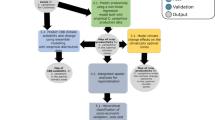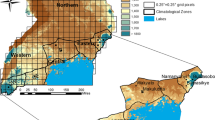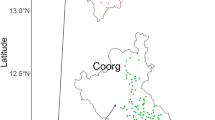Abstract
Ethiopia economy depends strongly on Coffea arabica production. Coffee, like many other crops, is sensitive to climate change and recent studies have suggested that future changes in climate will have a negative impact on its yield and quality. An urgent development and application of strategies against negative impacts of climate change on coffee production is important. Agroforestry-based system is one of the strategies that may ensure sustainable coffee production amidst likelihood future impacts of climate change. This system involves the combination of trees in buffer extremes thereby modifying microclimate conditions. This paper assessed coffee production under: (1) coffee monoculture and (2) coffee grown using agroforestry system, under: (a) current climate and (b) two different future climate change scenarios. The study focused on two representative coffee growing regions of Ethiopia under different soil, climate and elevation conditions. A process-based growth model (yield-SAFE) was used to simulate coffee production for a time horizon of 40 years. Climate change scenarios considered were: representative concentration pathways (RCP) 4.5 and 8.5. The results revealed that in monoculture systems, the current coffee yields are between 1200 and 1250 kg ha−1 year−1, with expected decrease between 4–38 and 20–60% in scenarios RCP 4.5 and 8.5, respectively. However, in agroforestry systems, the current yields are between 1600 and 2200 kg ha−1 year−1, the decrease was lower, ranging between 4–13 and 16–25% in RCP 4.5 and 8.5 scenarios, respectively. From the results, it can be concluded that coffee production under agroforestry systems has a higher level of resilience when facing future climate change and reinforce the idea of using this type of management in the near future for adapting climate change negative impacts on coffee production.






Similar content being viewed by others
References
Alemu MM (2015) Effect of tree shade on coffee crop production. J Sustain Dev 8:66
Andrew EE, Yong FE, Seraphine ME, Ngane E (2013) Early growth, biomass allocation and water use efficiency of three species of tropical tree seedlings at four moisture level. Glob Adv Res J 2:47–58
Artru S, Garré S, Dupraz C et al (2017) Impact of spatio-temporal shade dynamics on wheat growth and yield, perspectives for temperate agroforestry. Eur J Agron 82:60–70. https://doi.org/10.1016/j.eja.2016.10.004
Belachew K, Teferi D (2015) Climatic variables and impact of coffee berry diseases (Colletotrichum Kahawae) in Ethiopian coffee production. J Biol Agric Healthc 5:55–65
Binkley D, Ryan MG (1998) Net primary production and nutrient cycling in replicated stands of Eucalyptus saligna and Albizia facaltaria. For Ecol Manag 112:79–85
Binkley D, Dunkin KA, Debell D, Ryan MG (1992) Production and nutrient cycling in mixed plantations of Eucalyptus and Albizia in Hawaii. For Sci 38:28–45
Bossolasco L (2009) A study case on coffee (Coffea arabica L.): Limu Coffee. p. 187
Bote A, Struik P (2011) Effects of shade on growth, production and quality of coffee (Coffea arabica) in Ethiopia. J Hortic For 3:336–341
Camargo B (2010) Review on the impact of climate variablity and climate cnhage on coffee crop in Brazil. Bragainas Camp 69:239–247
Carabine E, Lemma A, Dupar M et al (2014) The IPCC’s fifth assessment report—what’s in it for Africa. Climate & Development Knowledge Network (CDKN), pp 1–33
Craparo ACW, Van Asten PJA, Läderach P et al (2015) Coffea arabica yields decline in Tanzania due to climate change: global implications. Agric For Meteorol 207:1–10
Crous-Duran J, Graves A, Paulo JA et al (2018) Modelling tree density effects on provisioning ecosystem services. Agrofor Syst 92:1–23
Damatta FM, Ramalho JDC (2006) Review on impacts of drought and temperature stress on coffee physiology and production. Braz J Plant Physiol 18:55–81
Davis AP, Gole TW, Baena S, Moat J (2012) The impact of climate change on indigenous Arabica coffee (Coffea arabica): predicting future trends and identifying priorities. PLoS ONE 7:10–14. https://doi.org/10.1371/journal.pone.0047981
Dias PC, Araujo WL, Moraes GA, Barros K et al (2007) Morphological and physiological responses of two coffee progenies to soil water availability. J Plant Physiol 164:1639–1647
Ebisa L (2014) Diversity of shade tree species in smallholder coffee farms, West Ethiopia. Sci Technol Art Res J 3:1–5
Ethiopian coffee exportation. https://www.ecx.com.et/commodities.aspx#COFFEE. Accessed on 30 Nov 2018.
Gole T (2015) Coffee: Ethiopia’s gift to the world. The traditional production systems as living examples of crop domestication, and sustainable production and an assessment of different certification schemes, pp 61.
Graves AR, Burgess PJ, Palma JHN et al (2007) Development and application of bio-economic modelling to compare silvoarable, arable, and forestry systems in three European countries. Ecol Eng 29:434–449. https://doi.org/10.1016/j.ecoleng.2006.09.018
Graves AR, Burgess PJ, Palma J et al (2010) Implementation and calibration of the parameter-sparse yield-SAFE model to predict production and land equivalent ratio in mixed tree and crop systems under two contrasting production situations in Europe. Ecol Modell 221:1744–1756. https://doi.org/10.1016/j.ecolmodel.2010.03.008
Hirons M, Mehrabi Z, Gonfa TA et al (2018) Pursuing climate resilient coffee in Ethiopia—a critical review. Geoforum 91:108–116. https://doi.org/10.1016/j.geoforum.2018.02.032
Holst J, Liu W, Xiao H et al (2012) Agroforestry—exploring a mitigation option for nitrogen pollution in cropping systems of the North China Plain. In: Online Proceedings of the 8th Asian conference for information technology in agriculture, Taipei
ICO (2016) Total production by all exporting countries. International Coffee Organisation
Imbach P, Fung E, Hannah L et al (2017) Coupling of pollination services and coffee suitability under climate change. Proc Natl Acad Sci 114:201617940. https://doi.org/10.1073/pnas.1617940114
Jaramillo J, Muchugu E, Vega FE et al (2011) Some like it hot: the influence and implications of climate change on coffee berry borer (Hypothenemus hampei) and coffee production in East Africa. PLoS ONE 6:1–14. https://doi.org/10.1371/journal.pone.0024528
Jassogne L, Laderach P, Van Asten P (2013) The impact of climate cnhage on coffee in Uganda. Lessons from a case study in the Rwenzori Mountains, p 16
Jayakumar M, Rajavel M, Surendran U (2016) Climate-based statistical regression models for crop yield forecasting of coffee in humid tropical Kerala, India. Int J Biometeorol 60:1943–1952. https://doi.org/10.1007/s00484-016-1181-4
Kufa T, Burkhardt MJ (2011) Plant composition and growth of wild Coffea arabica: implications for management and conservation of natural forest resources. Int J Biodivers Conserv 3:131–141
Kufa T, Burkhardt J (2015) Physiological growth response in seedlings of Arabica coffee genotypes under contrasting nursery microenvironments. Plant 3:47–56
Labouisse J, Bellache B, Kotecha S, Bertrand B (2008) Current status of coffee (Coffea arabica L.) genetic resources in Ethiopia: implications for conservation. Genet Resour Crop Evol 55:1079–1093. https://doi.org/10.1007/s10722-008-9361-7
Lin BB (2010) The role of agroforestry in reducing water loss through soil evaporation and crop transpiration in coffee agroecosystems. Agric For Meteorol 150:510–518. https://doi.org/10.1016/j.agrformet.2009.11.010
Luedeling E, Smethurst PJ, Baudron F et al (2016) Field-scale modeling of tree-crop interactions: challenges and development needs. Agric Syst 142:51–69
Minten B, Tamru S, Kuma T, Nyarko Y (2015) Structure and performance of Ethiopia’s coffee export sector. Ethiopia strategy support program working paper, Addis Ababa, p 66
Missanjo E, Maya C (2015) Survival and growth response of seedlings to seed size variation of Albizia lebbeck (L.) Benth. J Agric Ecol Res Int 3:67–74
Moat J, Williams J, Baena S et al (2017) Coffee farming and climate change in Ethiopia: impacts, forecasts, resilience and opportunities—summary. The Strategic Climate Institutions Programme (SCIP). Royal Botanic Gardens, Kew (UK), p 37
Montoya JWM, Valenzuela JRC, Herrera NMR (2013) Morphometric and productive characterization of nineteen genotypes from the Colombian Coffea Collection. Rev Fac Nal Agr Medel 66:7021–7034
Muleta D, Assefa F, Nemomissa S, Granhall U (2011) Organic material socioeconomic benefits of shade trees in coffee production systems in Bonga and Yayu-Hurumu Districts, Southwestern Ethiopia: Farmers’ Perceptions. Ethiop J Educ Sci 12:39–56
Negash M, Kanninen M (2015) Modeling biomass and soil carbon sequestration of indigenous agroforestry systems using CO2FIX approach. Agric Ecosyst Environ 203:147–155
Netsere A, Kufa T (2015) Determining suitable shade trees, panting pattern and spacing for Arabica Coffee production in South and Southwestern. J Biol Agric Healthc 5:9–16
Ngo HT, Mojica AC, Packer L (2011) Coffee plant–pollinator interactions: a review. Can J Zool 89:647–660. https://doi.org/10.1139/Z11-028
Nonato H, Souza D, De Goede RGM et al (2012) Agriculture, ecosystems and environment protective shade, tree diversity and soil properties in coffee agroforestry systems in the Atlantic Rainforest biome. Agric Ecosyst Environ 146:179–196. https://doi.org/10.1016/j.agee.2011.11.007
Oijen M, Dauzat J, Harmand J-M et al (2010) Coffee agroforestry systems in Central America: II. Development of a simple process-based model and preliminary results. Agrofor Syst 80:361–378
Palma J, Graves A, Bunce R et al (2007) Modelling environmental benefits of silvoarable agroforestry in Europe. Agric Ecosyst Environ 119:320–334
Palma JHN, Paulo JA, Tomé M (2014) Carbon sequestration of modern Quercus suber L. silvoarable agroforestry systems in Portugal: ayieldSAFE-based estimation. Agrofor Syst 88:791–801. https://doi.org/10.1007/s10457-014-9725-2
Palma JHN, Graves AR, Crous-Duran J et al (2017) Yield-SAFE model improvements. Milestone Report 29 (6.4) for EU FP7 Research Project: AGFORWARD 613520, p 30
Palma JHN, Crous-Duran J, Graves AR et al (2018) Integrating belowground carbon dynamics into yield-SAFE, a parameter sparse agroforestry model. Agrofor Syst. 92:1047–1057. https://doi.org/10.1007/s10457-017-0123-4
Rodrigues WN, Tomaz MA, Ferrão MAG et al (2015) Biometry and diversity of Arabica coffee genotypes cultivated in a high density plant system. GenetMolRes 15:1–12
Talemos S, Sebsebe D (2014) Diversity and standing carbon stocks of native Agroforestry trees in Wenago district, Ethiopia. J Emerg Trends Eng Appl Sci (JETEAS) 5:25–132
van der Werf W, Keesman K, Burgess P et al (2007) Yield-SAFE: a parameter-sparse process-based dynamic model for predicting resource capture, growth and production in agroforestry systems. Ecol Eng 29:419–433
Wayne GP (2013) The Beginner’s guide to representative concentration pathways (RCPs), pp 1–24
Wondrade N, Dick O, Tveite H (2015) Estimating above ground biomass and carbon stock in the Lake Hawassa Watershed, Ethiopia by Integrating Remote Sensing and Allometric Equations. For Res 04:151. https://doi.org/10.4172/2168-9776.1000151
Acknowledgements
We gratefully acknowledged for the program of education, training, youth and sport of the European Commission for its financial support for the study of the first author in the Erasmus Mundus MEDOFR program. We also thank European Union FP7 Project AGFORWARD (Agroforestry that will advance rural development—contract nr 613520).
Author information
Authors and Affiliations
Corresponding author
Additional information
Publisher's Note
Springer Nature remains neutral with regard to jurisdictional claims in published maps and institutional affiliations.
Rights and permissions
About this article
Cite this article
Gidey, T., Oliveira, T.S., Crous-Duran, J. et al. Using the yield-SAFE model to assess the impacts of climate change on yield of coffee (Coffea arabica L.) under agroforestry and monoculture systems. Agroforest Syst 94, 57–70 (2020). https://doi.org/10.1007/s10457-019-00369-5
Received:
Accepted:
Published:
Issue Date:
DOI: https://doi.org/10.1007/s10457-019-00369-5




